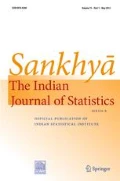Abstract
In this note two easily applied moment tests of the Rayleigh hypothesis are compared with the Anderson-Darling test, some smooth tests and tests based on the empirical Laplace transform.

Similar content being viewed by others
References
Gürtler, N., and N. Henze. 2000. Recent and classical goodness-of-fit tests for the Poisson distribution. Journal of Statistical Planning and Inference 90: 207–225.
Henze, N., and B. Klar. 1996. Properly rescaled components of smooth tests of fit are diagnostic. Australian Journal of Statistics 38: 61–74.
IMSL. 1995. Users’ manual. Houston: IMSL.
Meintanis, S., and G. Iliopoulos. 2003. Tests of fit for the Rayleigh distribution based on the Empirical Laplace transform. Annals of the Institute of Statistical Mathematics 55(1): 137–151.
Neyman, J. 1937. ‘Smooth’ test for goodness of fit. Skandinavisk Aktuarietidskrift 20: 150–199.
Rayner, J.C.W., and D.J. Best. 1989. Smooth tests of goodness of fit. New York: Oxford University Press.
Rayner, J.C.W., D.J. Best, and K.L. Mathews. 1995. Interpreting the skewness coefficient. Communications in Statistics—Theory and Methods 24(3): 593–600.
Rayner, J.C.W., O. Thas, and B. De Boeck. 2008. A generalised Emerson recurrence relation. Australian and NZ Journal of Statistics 50(3): 235–240.
Rayner, J.C.W., O. Thas, and D.J. Best. 2009. Smooth tests of goodness of fit: using R, 2nd ed. Singapore: Wiley.
Spinelli, J.J., and M.A. Stephens. 1997. Cramer-von Mises tests of fit for the Poisson distribution. Canadian Journal of Statistics 25: 257–268.
Thas, O., J.C.W. Rayner, D.J. Best, and B. De Boeck. 2009. Informative statistical analyses using smooth goodness of fit tests. Journal of Statistical Theory and Practice 3(3): 705–733.
Author information
Authors and Affiliations
Corresponding author
Appendix
Appendix
Asymptotically U √(n/0.37183) has a normal distribution with mean √(n/0.37183)E[U] and variance V. For the null case E[U] = 0 and V = 1. Asymptotically, for any alternative and using the delta method,
Here \( {f_x} = - \left( {{{8} \left/ {\pi } \right.} - 2} \right)\mu \), μ is the mean and μ r , r = 2, 3, ... are the central moments of the alternative distribution. The asymptotic power of U for test size α = 0.05 and an alternative with E[U] = 0 is
Suppose the alternative is a rectangular distribution with support (a, b), R(a, b) say, in which \( a = \surd \left( {\pi /2} \right) - \surd \left\{ {3\left( {2 - \pi /2} \right)} \right\} \) and \( b = 2\surd \left( {\pi /2} \right) - a \). Then E[R] = √(π/2) and var(R) = 2−π/2, equal to the corresponding moments of the Rayleigh distribution with θ = 1, so that asymptotically E[U] = 0 and V = 0.3487. Thus the asymptotic power of U is
Thus asymptotically the test based on U is biased, albeit that the bias is only slight.
The following table shows how the power of the test based on U approaches its asymptotic limit as n→∞. The finite sample powers for the test based on U in Table 5 are calculated by parametric bootstrap with 1,000 simulations in both the inner and outer loops.
Rights and permissions
About this article
Cite this article
Best, D.J., Rayner, J.C.W. & Thas, O. Easily applied tests of fit for the Rayleigh distribution. Sankhya B 72, 254–263 (2010). https://doi.org/10.1007/s13571-011-0011-2
Received:
Revised:
Accepted:
Published:
Issue Date:
DOI: https://doi.org/10.1007/s13571-011-0011-2


